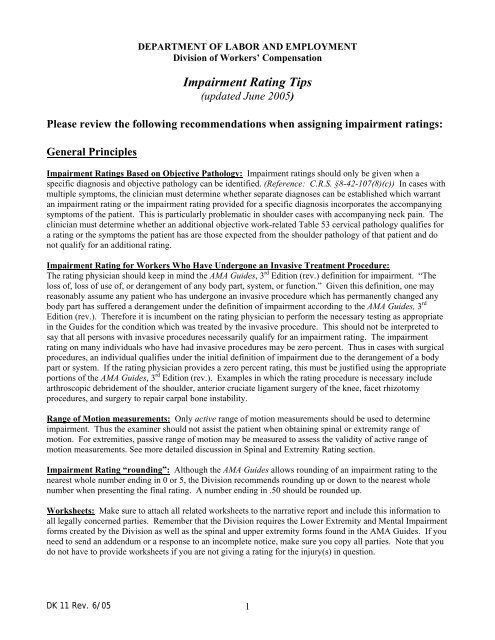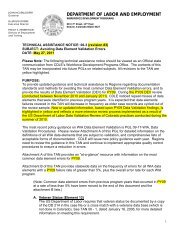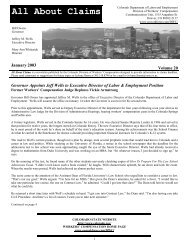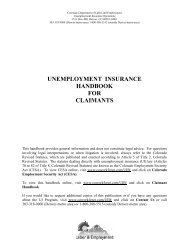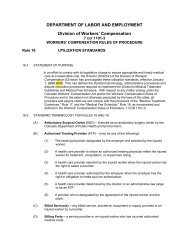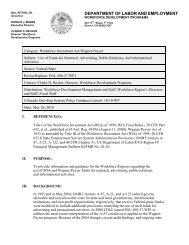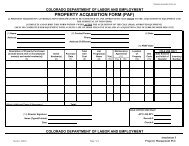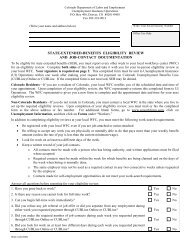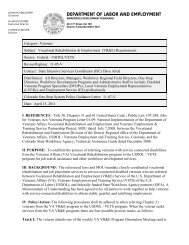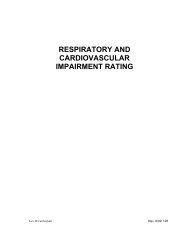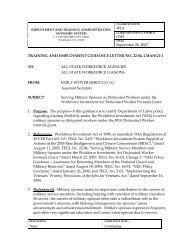Impairment Rating Tips - Colorado Department of Labor and ...
Impairment Rating Tips - Colorado Department of Labor and ...
Impairment Rating Tips - Colorado Department of Labor and ...
You also want an ePaper? Increase the reach of your titles
YUMPU automatically turns print PDFs into web optimized ePapers that Google loves.
DEPARTMENT OF LABOR AND EMPLOYMENT<br />
Division <strong>of</strong> Workers’ Compensation<br />
<strong>Impairment</strong> <strong>Rating</strong> <strong>Tips</strong><br />
(updated June 2005)<br />
Please review the following recommendations when assigning impairment ratings:<br />
General Principles<br />
<strong>Impairment</strong> <strong>Rating</strong>s Based on Objective Pathology: <strong>Impairment</strong> ratings should only be given when a<br />
specific diagnosis <strong>and</strong> objective pathology can be identified. (Reference: C.R.S. §8-42-107(8)(c)) In cases with<br />
multiple symptoms, the clinician must determine whether separate diagnoses can be established which warrant<br />
an impairment rating or the impairment rating provided for a specific diagnosis incorporates the accompanying<br />
symptoms <strong>of</strong> the patient. This is particularly problematic in shoulder cases with accompanying neck pain. The<br />
clinician must determine whether an additional objective work-related Table 53 cervical pathology qualifies for<br />
a rating or the symptoms the patient has are those expected from the shoulder pathology <strong>of</strong> that patient <strong>and</strong> do<br />
not qualify for an additional rating.<br />
<strong>Impairment</strong> <strong>Rating</strong> for Workers Who Have Undergone an Invasive Treatment Procedure:<br />
The rating physician should keep in mind the AMA Guides, 3 rd Edition (rev.) definition for impairment. “The<br />
loss <strong>of</strong>, loss <strong>of</strong> use <strong>of</strong>, or derangement <strong>of</strong> any body part, system, or function.” Given this definition, one may<br />
reasonably assume any patient who has undergone an invasive procedure which has permanently changed any<br />
body part has suffered a derangement under the definition <strong>of</strong> impairment according to the AMA Guides, 3 rd<br />
Edition (rev.). Therefore it is incumbent on the rating physician to perform the necessary testing as appropriate<br />
in the Guides for the condition which was treated by the invasive procedure. This should not be interpreted to<br />
say that all persons with invasive procedures necessarily qualify for an impairment rating. The impairment<br />
rating on many individuals who have had invasive procedures may be zero percent. Thus in cases with surgical<br />
procedures, an individual qualifies under the initial definition <strong>of</strong> impairment due to the derangement <strong>of</strong> a body<br />
part or system. If the rating physician provides a zero percent rating, this must be justified using the appropriate<br />
portions <strong>of</strong> the AMA Guides, 3 rd Edition (rev.). Examples in which the rating procedure is necessary include<br />
arthroscopic debridement <strong>of</strong> the shoulder, anterior cruciate ligament surgery <strong>of</strong> the knee, facet rhizotomy<br />
procedures, <strong>and</strong> surgery to repair carpal bone instability.<br />
Range <strong>of</strong> Motion measurements: Only active range <strong>of</strong> motion measurements should be used to determine<br />
impairment. Thus the examiner should not assist the patient when obtaining spinal or extremity range <strong>of</strong><br />
motion. For extremities, passive range <strong>of</strong> motion may be measured to assess the validity <strong>of</strong> active range <strong>of</strong><br />
motion measurements. See more detailed discussion in Spinal <strong>and</strong> Extremity <strong>Rating</strong> section.<br />
<strong>Impairment</strong> <strong>Rating</strong> “rounding”: Although the AMA Guides allows rounding <strong>of</strong> an impairment rating to the<br />
nearest whole number ending in 0 or 5, the Division recommends rounding up or down to the nearest whole<br />
number when presenting the final rating. A number ending in .50 should be rounded up.<br />
Worksheets: Make sure to attach all related worksheets to the narrative report <strong>and</strong> include this information to<br />
all legally concerned parties. Remember that the Division requires the Lower Extremity <strong>and</strong> Mental <strong>Impairment</strong><br />
forms created by the Division as well as the spinal <strong>and</strong> upper extremity forms found in the AMA Guides. If you<br />
need to send an addendum or a response to an incomplete notice, make sure you copy all parties. Note that you<br />
do not have to provide worksheets if you are not giving a rating for the injury(s) in question.<br />
DK 11 Rev. 6/05 1
Apportionment<br />
Apportionment <strong>of</strong> Prior Conditions: Asymptomatic conditions cannot be evaluated for prior impairment.<br />
Only previously symptomatic conditions should be considered for apportionment. (Reference: Askew v.<br />
Industrial Claim Appeals Office, 927 P.2d 1333 (Colo. 1996); Rule XIX). To apportion you must create a rating<br />
<strong>of</strong> the workers’ impairment immediately prior to the current injury or disease using the AMA Guides, 3 rd Edition<br />
(revised). Subtract this rating from the current total rating at the appropriate levels. The current rating should<br />
represent the person’s current impairment including the prior injury. You may not apportion by only estimating<br />
the percentage attributable to the prior injury or disease; for example, “50% <strong>of</strong> this impairment was preexisting.”<br />
You must have medical documentation for the information that substantiates the previous rating.<br />
Age: Because age is considered in the calculation <strong>of</strong> benefits which the injured worker will receive, there is no<br />
additional apportionment for age when awarding impairment ratings (Reference: C.R.S. §8-42-107).<br />
Spinal <strong>and</strong> Extremity <strong>Rating</strong><br />
Table 53 <strong>and</strong> Application <strong>of</strong> Spinal Range <strong>of</strong> Motion: In order to be assigned a spinal rating, the patient must<br />
have objective pathology <strong>and</strong> impairment that qualifies for a numerical impairment rating <strong>of</strong> greater than zero<br />
under Table 53. Spinal range <strong>of</strong> motion impairment must be completed <strong>and</strong> applied to the impairment rating<br />
only when a corresponding Table 53 diagnosis has been established. (References: Spine section <strong>of</strong> the AMA<br />
Guides, 3 rd Edition (revised); Level II Accreditation Curriculum, Spinal <strong>Impairment</strong>). In unusual cases with<br />
established severe shoulder pathology an isolated cervical range <strong>of</strong> motion impairment may be allowed if welljustified<br />
by the clinician. Otherwise there are no exceptions to the requirement for a corresponding Table 53<br />
rating.<br />
Table 54: Although Tables 53 <strong>and</strong> 54 are mutually exclusive <strong>and</strong> cannot be used in the same rating (Reference:<br />
Level II Accreditation Curriculum, Spine/Lower Extremity, Diagnosis-Related Factors <strong>and</strong> pg. 81 AMA Guides),<br />
remember that in some cases with ankylosis as a pre-existing condition Table 54 can be used for apportionment.<br />
In such cases, Table 53 can be used for the current rating <strong>and</strong> Table 54 can be used for the previous rating.<br />
Straight-Leg Raise Check (SLR) for Invalidation <strong>of</strong> Lumbar Flexion: The SLR check applies to lumbar<br />
flexion only. Of the SLR measurements for each leg, the evaluator records the MAXIMUM SLR for each leg.<br />
Then the ‘tightest’ or the ‘lowest’ <strong>of</strong> these two maximum measurements for the right <strong>and</strong> left leg is used to the<br />
compare to the sum <strong>of</strong> sacral flexion <strong>and</strong> extension (Reference: Level II Accreditation Curriculum, Range <strong>of</strong><br />
Motion Testing for the Spine).<br />
Invalidation <strong>of</strong> Spinal Range <strong>of</strong> Motion (cervical, thoracic, lumbar): To invalidate spinal range <strong>of</strong> motion<br />
impairment, claimants must have two visits. Two sets <strong>of</strong> three measurements must be taken on each visit (12<br />
measurements total). When a physician performing a Division IME finds range <strong>of</strong> motion measurements<br />
invalid, such physician may fulfill this requirement by accepting invalidated measurements from other reports in<br />
lieu <strong>of</strong> bringing the claimant back for a second set <strong>of</strong> measurements. The physician must, however, report<br />
his/her own initial sets <strong>of</strong> measurements. (Reference: Level II Accreditation Curriculum, Range <strong>of</strong> Motion<br />
Testing for the Spine).<br />
Lumbar Flexion <strong>Impairment</strong>: When using Table 60, you must first reference the sacral flexion angle (1 st<br />
column), then the true lumbar flexion angle to calculate the impairment percentage for true lumbar flexion.<br />
(Reference: Table 60, pg. 98, AMA Guides, 3 rd Edition (revised)).<br />
Angle <strong>of</strong> Minimum Kyphosis, Thoracic Flexion Worksheet: Angle <strong>of</strong> minimum kyphosis must be recorded<br />
in addition to the other measurements. This is because it is the GREATER <strong>of</strong> the two impairments (between<br />
thoracic flexion <strong>and</strong> angle <strong>of</strong> minimum kyphosis) which is used in the rating (Reference: Section 3.3d, pg. 91,<br />
AMA Guides, 3 rd Edition (revised)).<br />
DK 11 Rev. 6/05 2
Only Unassisted, Active Range <strong>of</strong> Motion Measurements Can Be Used in <strong>Impairment</strong> <strong>Rating</strong>:<br />
The AMA Guides to the Evaluation <strong>of</strong> Permanent <strong>Impairment</strong>, 3 rd revised edition, discusses the measurement <strong>of</strong><br />
active <strong>and</strong> passive ranges <strong>of</strong> motion, however only active, patient-initiated, range <strong>of</strong> motion should be used to<br />
determine impairment. (AMA Guides 3rd edition (rev.) pp. 18, 55, 81) Any form <strong>of</strong> “assisted range <strong>of</strong> motion”<br />
is not part <strong>of</strong> the impairment rating process. Physicians’ physical examination records should identify the<br />
measurements which reflect active, unassisted range <strong>of</strong> motion. If there is a significant, non-physiologic<br />
difference between the active <strong>and</strong> passive ranges <strong>of</strong> motion, physicians should have the patient stretch <strong>and</strong><br />
repeat the measurements. When the physician believes the active range <strong>of</strong> motion obtained is non-physiologic,<br />
the physician is encouraged to inform the patient <strong>of</strong> their impression <strong>and</strong> the fact that it may affect the patient’s<br />
rating, before obtaining another trial <strong>of</strong> measurements. If repeat measurements continue to appear significantly<br />
non-physiologic, the physician may use measurements obtained by other providers when there is reason to<br />
believe the measurements were performed according to the AMA Guides st<strong>and</strong>ards.<br />
<strong>Rating</strong> Extremities Using the Contralateral Joint: In some cases the contralateral joint is a better<br />
representation <strong>of</strong> the patient’s pre-injury state than the AMA Guides population norms. The 3rd Revised Edition<br />
has little commentary on this procedure, however the 5 th Edition <strong>and</strong> the Division consider it reasonable to<br />
compare both extremities when there are specific conditions which would make the opposite, non-injured<br />
extremity serve as a better baseline. Therefore, when deemed appropriate, the physician may subtract the<br />
contralateral joint ROM impairment from the injured joint’s ROM impairment. (An example would be a patient<br />
with limited knee flexion due to obesity.) However, this subtraction should not be done if the contralateral joint<br />
has a known previous injury because that joint may not reflect the ‘normal’ ROM for that individual. Make<br />
sure that you explain your methodology <strong>and</strong> your rationale in your report.<br />
Shoulder Surgery: Resection arthroplasty referred to in the AMA Guides 3 rd Edition Revised is to be used<br />
only for partial resection <strong>of</strong> the humeral head, a procedure rarely performed currently. Neither resection nor<br />
implant arthroplasty values should be used for a distal clavicular resection. The value assigned to a distal<br />
clavicular arthroplasty is 10%. The AMA Guides 4 th <strong>and</strong> 5 th Editions continue to suggest that subacromial<br />
arthroplasty should be rated using ROM, <strong>and</strong> when appropriate, ‘joint crepitation with motion’ from the “Other<br />
Disorders” section. In general, when any additional rating for subacromial arthroplasty is deemed appropriate in<br />
a case with or without crepitus, it should not exceed 10%.<br />
Peripheral Nerve Injuries Resulting from Cumulative Trauma: All peripheral nerve injuries should be rated<br />
under the peripheral nerve tables in the AMA Guides 3 rd Ed. Rev.: for upper extremity – Table 14 (p. 46), <strong>and</strong><br />
for lower extremity – Table 51 (p. 77). The peripheral nerve values are then multiplied by percentages in Table<br />
10 (grading scheme sensory function-p. 42), or Table 11 (grading scheme for motor function-p. 42). For further<br />
information, you may also consult ‘Helpful Hints for Grading Neurological Deficits’ (Level II Accreditation<br />
Curriculum). Range <strong>of</strong> motion or the CTD rating system should only be used if there is a separate <strong>and</strong> distinct<br />
non-neurologic cumulative trauma diagnosis (such as DeQuervain’s). Remember that the terms ‘cumulative<br />
trauma disorder,’ ‘repetitive motion syndrome,’ ‘repetitive strain injury,’ <strong>and</strong> other similar nomenclatures are<br />
umbrella terms that are not acceptable diagnoses. (Cumulative Trauma Disorder Treatment Guidelines,<br />
‘Definitions <strong>and</strong> Mechanisms <strong>of</strong> Injury’). Specific diagnoses must be provided prior to the assignment <strong>of</strong> an<br />
impairment rating.<br />
Other <strong>Impairment</strong><br />
Disfigurement: Physicians may, if they deem appropriate, give a rating for scars using the AMA Guides 3 rd<br />
Edition (revised), even though there is an option for the claimant to go to an ALJ to request additional award.<br />
(Reference: Level II Accreditation Curriculum, Dermatology, section on Disfigurement; <strong>Colorado</strong> Revised<br />
Statutes (C.R.S. §8-42-108).<br />
DK 11 Rev. 6/05 3
Complex Regional Pain Syndrome (CRPS)-formerly known as Reflex Sympathetic Dystrophy: The Division<br />
recommends using the spinal cord table (Table 1, pg. 109, AMA Guides) for determining impairment, however<br />
the peripheral nerve tables may be used if the evaluator deems them more appropriate (Table 14, pg. 46; Table<br />
51, pg. 77, Table 10 pg. 42, AMA Guides). In unusual cases where severe vascular symptoms cause additional<br />
impairment <strong>of</strong> ADL’s the physician may choose to combine additional impairment for the vascular tables with<br />
the neurological impairment. (Table 52, pg. 79 <strong>and</strong> Table 16, pg. 47, AMA Guides). Range <strong>of</strong> motion should<br />
not be used, as this would be accounted for in the neurologic portion <strong>of</strong> the rating.<br />
Additional Notes for Physicians on the IME Panel:<br />
IME Application: When completing the narrative <strong>and</strong> worksheets for the IME, make sure you address all <strong>of</strong><br />
the issues <strong>and</strong>/or all <strong>of</strong> the body parts listed on the IME application. Some <strong>of</strong> them are very specific.<br />
Performing <strong>Rating</strong>s: Just because you are asked to address a body part or condition that is listed on an IME<br />
application does not mean you have to rate that condition if you do not feel it is work-related or qualifies for<br />
permanent impairment. You should, however, acknowledge it in some fashion to ensure that all listed issues are<br />
addressed. Remember that you do not have to provide worksheets if you are not giving a rating for the injury(s)<br />
in question.<br />
MMI Status: Be specific about MMI status <strong>and</strong> date <strong>of</strong> MMI. If you agree with an authorized treating<br />
physician regarding MMI status <strong>and</strong> date, state the name <strong>of</strong> that doctor as well as the MMI date. Some changes<br />
have been made to the IME summary sheet to reflect this need for more specific information.<br />
<strong>Impairment</strong> when “Not at MMI”: Remember that an IME is a legal/medical proceeding <strong>and</strong> you are being<br />
asked to provide specific information. If the party requesting the IME has asked that impairment be addressed,<br />
<strong>and</strong> if you find the patient not at MMI for that work-related injury, you should nevertheless provide a rating for<br />
that injury. This information can be used by the parties for negotiations, settlement, or to help assess further<br />
treatment needs.<br />
Recommendations for Additional Treatment: Division Independent Medical Examiners frequently<br />
recommend further treatment. To avoid ambiguity <strong>and</strong> controversy, we recommend that independent medical<br />
examiners consider the following legal opinion issued by the Industrial Claim Appeals Office, Gebert v.<br />
Nordstrom, Inc., W.C. No. 4-428-645 (ICAO, June 20, 2003), “A recommendation for therapies which present a<br />
reasonable prospect for improving physical function may be viewed as evidence that the claimant’s condition is<br />
not stable, <strong>and</strong> the resulting impairment is not measurable. Therefore such treatment recommendations are<br />
inconsistent with MMI…. Of course it is also true that treatment which is provided merely to maintain the<br />
claimant’s condition by preventing deterioration, or to relieve continuing symptoms, is not inconsistent with<br />
MMI <strong>and</strong> may be awarded thereafter.”<br />
The Division Independent Medical Examiner must clearly indicate whether the treatment recommendations in<br />
the IME report are intended as maintenance treatment or if the treatment could affect the MMI date given the<br />
above statement. If the examiner indicates that the treatment recommended would affect the MMI date, the<br />
examiner should also indicate whether the patient would be at maximum medical improvement as <strong>of</strong> a specific<br />
date in the event the patient refused to undertake the treatment suggested by the examiner. That “specific date”<br />
may or may not be the date <strong>of</strong> your exam. Remember that the statute defines MMI as: “A point in time when<br />
any medically determinable physical or mental impairment . . . has become stable <strong>and</strong> when no further<br />
treatment is reasonably expected to improve the condition. The requirement for future medical maintenance<br />
which will not significantly improve the condition or the possibility <strong>of</strong> improvement or deterioration resulting<br />
from the passage <strong>of</strong> time shall not affect a finding <strong>of</strong> [MMI].”<br />
DK 11 Rev. 6/05 4


